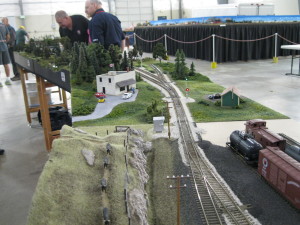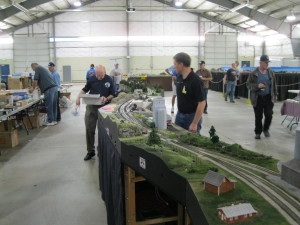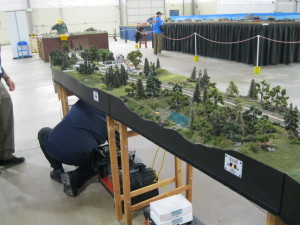by Alan Ashton
Editors note: Alan Ashton is the former 5th Division newsletter editor and is now promoting and explaining Free-mo. This article has been updated to clarify the Digitrix Loconet requirements as noted by Mark Clemmens in his comment. Articles on Free-mo from other authors are very appreciated and can be sent to gi_editor@4dpnr.com. Alan can be reached at inwafreemo@gmail.com.
I have been a model railroader for many years and it didn’t take too long for me to decide that I would like to build a Free-mo module. My reasons for doing so include:
- Building and storing a module won’t take up much space
- Having a module will enable me to meet and interact with more people who share a common interest
- Construction costs won’t be prohibitive
- I will learn about new materials and techniques
- I have the time and interest to learn about a new aspect of my favorite hobby
As I began to explore Free-mo options, I had a lot of questions. In this article I will use a question and answer format that I hope will be useful to you if you have an interest in building a module. At one point or another, I asked these questions and I will now share what I have learned with you.
Q. What scales are represented in Free-mo designs?
A. Free-mo is primarily for HO scale modelers but the standards have been adopted for other scales including N and O. In our area (Northern Idaho and Spokane) there is a group modeling in N scale. Unless I specify otherwise, all of the references in the articles that I publish here are referencing HO scale.
Q. Where can I find a list of the standards?
A. The official Free-mo website is the place to start: http://www.free-mo.org/about.
Q. How strictly must I follow the standards?
A. In order for you to participate in Free-mo events your module must conform to most of the standards. However, many larger clubs or associations of Free-mo modelers may choose to embellish the overall standards to suit their purposes. For example, the standards state that the nominal height from the floor to the rail head must be 50-inches (S2.4). That works really well for operations but it makes it difficult for many children to see the layout during shows. Therefore, some groups have elected to make adjustable legs that will allow the height to the railhead either 50-inches (operations height) or 42-inches (show height) from the floor.
Q. Where are Free-mo events held?
A. Free-mo events are held all over the world. But, before you pack you module and travel to Paris (France, not Texas) you may want to make sure that your module conforms to European standards. More locally, Free-mo layouts are appearing at train shows, NMRA meetings and at specially organized Free-mo events. There is no regular schedule or calendar of events so watch local websites and Facebook pages that are devoted to Free-mo groups.
Q. Is there a fee to join a Free-mo event?
A. Sometimes there is a nominal fee to cover space rental, access to electricity and (possibly) liability insurance. Generally, the fee won’t exceed $50 and many events are held without cost to the exhibitors (the Spokane Train Show, for example).
Q. Can I attend a Free-mo event if I don’t have a module?
A. If you want to gather more information before committing to build a module you should go to a Free-mo event and ask questions. The event organizers will determine if there is a fee or any restrictions on your participation.
Q. How much does a module cost?
A. Module costs will depend upon size and complexity but a basic framework (including electrical parts but without track and scenery) should run about $100 to $125. This estimate will vary upon how many of the parts you have on-hand and if you can pool resources with other modelers. From time-to-time, I will send emails regarding sources and prices for Free-mo components.
Q. Where do I find the materials to build my module(s)?
A. Many of the components may be sourced locally but others are best found on the internet. As I publish additional articles and emails, I will list some of the sources that I am aware of. If you have suggestions or knowledge of sources, send them to me and I will add them to a database for distribution through our mailing list.
Q. What special tools do I need?
A. You probably have most of the tools that you will need to finish the modeling scene that you want. You will, however, need some good woodworking tools to cut the end plates, side rails, legs and leg pockets. Accuracy is very important to achieve good mating with adjacent modules. If you live in an apartment or don’t have access to at least a good table saw, this could be an impediment for constructing a solid module base for scenery and compliance with standards. There are solutions and I will discuss a few of these in a follow-up article.
Q. Must I use Digitrax DCC equipment?
A. The Free-mo standard specifies Digitrax Loconet for accessory interoperability. Specifically, the standard specifies the use of a 6-conductor connection for the cab and accessory bus which follows the Digitrax LocoNet wiring specification. Besides Digitrax at least one other DCC system (NCE) uses this 6-conductor wiring for the accessory bus. However, for operating trains only one system can be providing the command and control across all of the modules at an event and typically this is a Digitrax command station along with Digitrax throttles. Some clubs or groups specify and use NCE DCC command and control when the modules are connected within their club (only).
At a minimum, you will need to provide two UP5 (LocoNet Universal Interconnect Panel) panels for each module that you build. Alternatively you can use the NCE UTP RJ-12 fascia panels (vs Digitrax UP5s) and they will support either NCE or Digitrax (the Digitrax panels will not work with NCE cabs, but the NCE panels will support LocoNet).
If you want to run trains, you will need a Digitrax (or NCE when appropriate) throttle of your choice. Command stations and boosters will be needed but not everyone will be required to bring these to an event. Depending upon the size of the event layout, there may be more than one power district and you must provide a way to isolate your module from an adjacent module.
Q. What is the best way to transport my module?
A. Getting a module to an event shouldn’t be a problem unless you have constructed one that is too long to fit into your vehicle. More adventuresome Free-mo modelers may use a truck, motor home or trailer to move multiple modules. It is all a matter of personal preference and the availability of transportation. Equally important is how to get your module to events without damage. More will follow about this latter point.
Q. Can I use the same type of track that I have on my home layout?
A. In order to fit with adjacent modules, the mainline track must be code 83. Otherwise, there are no restrictions. I will discuss track planning in a future article.
Q. Are there standards for scenery?
A. Yes, but they are very general and do not restrict the overall intent of your personal scenery choices. Clubs and loose-knit associations of modelers may decide to model an area of the country (northwest) or era (transition) but these are not specified in the Free-mo standards. This means, for example, that your module that features a northwest scene might be connected to modules that have desert scenery. That is perfectly acceptable and doesn’t detract from the Free-mo experience.
Q. Who decides how the modules will be set up for an event?
A. Generally, a coordinator (often referred to as the Run Chief) will be assigned the task of designing the layout so that it conforms to space limitations and power requirements. The coordinator will create a diagram showing the position and orientation of all of the modules that are expected to be at the event. The set up may be done by a designated team or by the owners of the individual modelers.
So this is my introduction. Future articles will cover my own experiences and observations related to the construction of my first Free-mo module: a list of materials, a platform for track and scenery, leg designs, wiring the module, track options, scenery, and transportation of the module. Your comments (addressed to inwafreemo@gmail.com or at the bottom of this post) are always welcome.




I must take issue with at least one thing that this author states as fact. Not all free-mo groups use Digitrax. Our PNW On30 group uses NCE as do several of the Free-moN groups. All that is required is that the cab bus be an Universal Cab Bus – using the 6 wire standard that several manufactures use. And you must NOT use the Digitrax UP5 plug in connectors, as they are not compatible with other systems.
Thanks for the article, I have recently been thinking about building a few modules when time permits, so I an anxious to read the follow-up articles.
-Stephen
The Western Washington – Northwest Oregon Free-moN group is active.
We participated with three other Free-moN groups at the National Train Show in Portland with 70+ modules and about 20 scale miles of track total.
A cab ride video may be seen at our website: http://www.pnwfreemo-n.org/
We will have a setup at the Puyallup show in November.
Please stop by and chat…